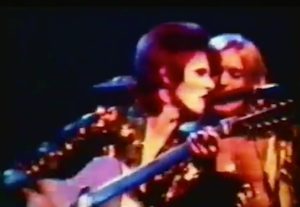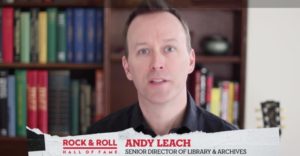Check out the new video from the Rock and Roll Hall of Fame Library and Archives on their NEO Sound project, featuring incredible rare clips from DEVO, The Dead Boys, and Aerosmith, The Who, Metallica, Elvis Costello, Bruce Springsteen and David Bowie, flyers of Iggy Pop, John Cale, and Pere Ubu, and a photo of the Cleveland Arena, the site of the world’s first-ever rock and roll concert. This collection is amazing. View the video here.
Andy Leach, senior director of the Rock and Roll Hall of Fame Library and Archives, says, “Right now is really the perfect time to be on the lookout for music memorabilia that you might want to donate to be part of our permanent collection.”
Not only is the Rock Hall looking for your photos, videos, audio, posters flyers, and memorabilia of local and touring artists, they are also reaching out to local musicians who might be hosting virtual events during the quarantine and encouraging them to donate recordings to be included in the NEO Sound collection.

We asked Andy a few questions about NEO Sound, and he responded in this exclusive interview.
COOLCLEVELAND: What makes Northeast Ohio special when it comes to rock and roll?
ANDY LEACH:Since the beginnings of rock and roll, Northeast Ohio has played an important role in its history. In the 50s, Alan Freed was one of the first white deejays to broadcast R&B, and he’s often recognized for coining the phrase “rock and roll” to refer to the musical style and for staging the first rock and roll concert here in Cleveland, the Moondog Coronation Ball. Cleveland also played a critical role in the 60s and 70s as FM and underground radio developed, with WMMS often being the first station in the country to break unknown artists who later became legendary. And, of course, Northeast Ohio has produced many important musicians and bands, including Devo, the Dead Boys, Pere Ubu, the Raspberries, the O’Jays, Chrissie Hynde, Joe Walsh, Trent Reznor, Bone Thugs-n-Harmony, and the Black Keys. And the local music scene is still vibrant today.

How did NEO Sound (formerly Northeast Ohio Popular Music Archives) begin? What were the initial key collections that were donated?
The Rock Hall knows how important this history is, and we recognized that it needs to collected and preserved for future generations. We wanted to provide a free, in-depth resource for researchers and fans to learn from, while also drawing from it to offer public programs and exhibits. One significant collection we had already owned was the Alan Freed Collection, and in 2012 we acquired the Jane Scott Papers, which is an extensive collection of Jane’s notebooks, photographs, and records that we received from her family after her passing. Since that time, we’ve been fortunate to receive photograph collections from Cleveland Scene Magazine and local photographers including Anastasia Pantsios, Dave Treat, and Bill Scheele, as well as an amazing collection of images taken by Jimmy Baynes, who shot photos in Cleveland R&B and jazz clubs for many years. We’ve also received donations from poster artists like Derek Hess and Sean Carroll, recordings of local college radio shows by deejays Steve Wainstead and Mike Kole, a great collection from the Swingos family about their famous hotel, and local companies like Dr. Z Amplification. A lot of this has been the result of the formation of our advisory group of local music experts who have extensive knowledge of the Northeast Ohio music scene as well as connections to musicians and others in the music business.
Are there some well-known musical figures who have donated their collections?
In addition to Jane Scott, we’ve received donations of papers and other materials from legendary music figures like Wally Bryson of the Raspberries, Jimmy Fox of the James Gang, and Chris Butler of the Waitresses and Tin Huey. We’ve also acquired collections from record executive and producer Tommy LiPuma, who was born and raised Cleveland, and manager/promoter Jim Clevo, who was well known around town among local musicians for years. Sadly, both Tommy and Jim have passed away since then, but we’re thankful that they entrusted us with their collections so their legacies can be preserved for the future.
What is the vision for NEO Sound? Where do you see it going? Do you expect more live events, conferences, musical events?
We’re still planning to host our third Home Movie Day event later this year, where we screen highlights of donated film and video footage showing local artists as well as national bands in local venues over the years, and we’re continually collecting donations for that. Beyond that, we’d like to host even more live events about local music, including interviews, performances, and panel discussions like the ones we’ve offered over the years. We also hope to continue curating new exhibits to showcase materials that are part of NEO Sound. The current exhibit at our Library & Archives focuses on punk and new wave music the came out of Northeast Ohio, and people should come and check that out after we’re open again.
Understanding that diversity is a strength of our region, can you identify a “NEO Sound?” Is there a type or style or sound that is similar amongst the collections?
I wouldn’t say there’s a common sound among all of it, because as you mentioned, there’s so much diversity and so many sounds and styles among the music of Northeast Ohio. Some common qualities I do see among the musicians here throughout the years, though, are aspects like ingenuity, independence, originality, and authenticity. So much great and interesting popular music has come out of our region, from rock to soul to hip hop, and we’re interested in collecting and celebrating all of it!
Andy suggests you visit their site and feel free to drop them an email at library@rockhall.org for those who have questions or want to donate.
View the video here.
https://library.rockhall.com/neosound